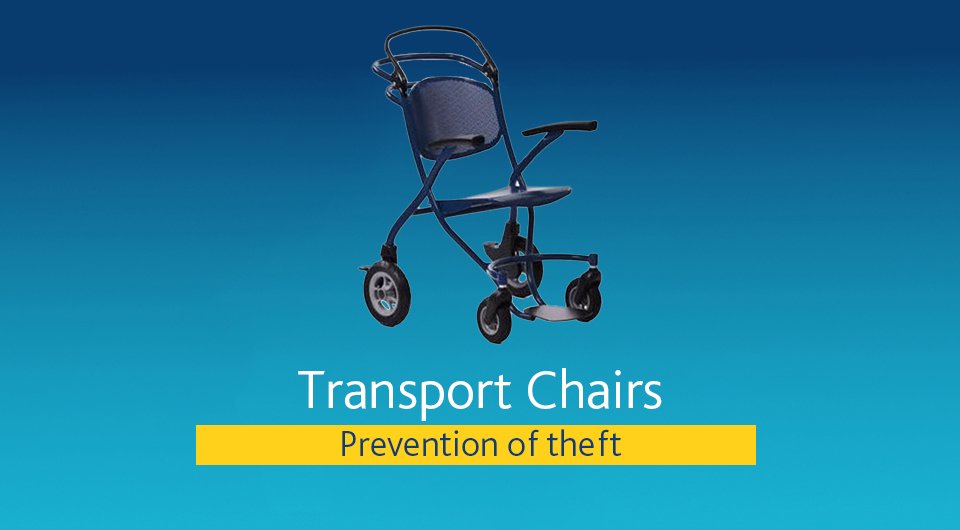For people with mobility issues, the right transport chair can make all the difference — helping users live an active life, and making venues more open and accessible to everyone who visits.
But as a mobile convenience, they can be hard to keep track of in a venue. And sadly, they can also be a tempting target for theft.
So to help reduce your risk (and help venues manage their stock), we’ve put together some simple security tips — to keep your transport chairs safe, and returned to where they should be.
Here are the steps you need to take:
|
Keep your transport chairs safe by:
|
1. Store it safely
If you have your own transport chair that you use for outings, it can be tempting to store it in your car overnight.
But cars and garages are prime targets for theft — they’re easily accessible, and easily visible.
So to keep your transport chair safe, you should always store it inside your home, where thieves are much less likely to get close to it.
If you don’t have space at home and you need to store your chair in a car or garage, the next-best thing will be to cover the chair with a sheet or a tarp — to reduce the temptation for anyone passing by.
2. Lock it in place
This is one step better than covering it with a sheet — and it works just as well outside the home, too.
If you’re working with a client who has some mobility, they won’t always need to be in their transport chair.
So if they ever need to leave their chair behind (to use the bathroom, or to sit in a restaurant), they can secure their chair with an anti-theft lock.
That could be a specialised wheelchair security lock, or even a simple bike lock — or any strong locking system that can be threaded through a welded part of the frame or the wheels.
3. Attach a tracker
This might not stop your chair from getting lost or stolen — but it will help you to track it down if something happens to it.
Modern tracking devices are now so small and affordable that they can be used for nearly anything. You could even use the same kind of device that you attach to keys or phones — like an Apple AirTag, or an equivalent tracking device for Android.
If you’re worried about losing your transport chair, it’s as simple as attaching the device securely to the chair.
But if you’re worried about theft, you’ll need to hide the tracker in a place where it won’t be found and removed — like on the underside of the seat, or even sewn into the fabric of the chair.
(Just remember: if you think your chair was stolen, don’t go tracking it on your own! Inform the police and give them the location, so you’re not putting yourself at risk.)
4. Use a coin lock
If you’re providing transport chairs in a public space or venue, it can be difficult to make sure you’re getting every chair back after it’s been used.
That’s why lots of venues choose transport chairs with accessories like a coin lock — as an incentive for their users to return the chairs once they’re finished with them.
It’s the same idea as the coin locks you see on supermarket trolleys. The lock is attached to a chain fixed to the wall, where users can free the chair by inserting a coin.
When they return the chair, they fit the lock back into place and get their coin back. So as long as they return it, it doesn’t cost them anything extra.
(It’s also a deterrent for anyone who might steal one. While a chair is worth much more than a coin, it can be enough to put off a potential thief.)
5. Attach an anti-theft post
Most stolen chairs aren’t wheeled from the scene of the crime: they’re loaded into vehicles and driven away.
An anti-theft post is designed for exactly that situation:

As well as creating an obvious visual marker — where a stolen chair would attract attention in any place outside of the venue — the long pole makes it difficult for a thief to fit a stolen chair into a car.
Need a chair with anti-theft accessories?
Our Axi2Go Transport Chairs can include both a Coin Lock and an Anti-theft Post as optional extras — to encourage your visitors to return their chairs, and reduce the risk of potential theft.




6. Fit an alarm
If you have to leave your chair somewhere — but there’s nowhere to lock it to — an anti-theft alarm could be the best option.
Just like with a lock, you can use a specialised wheelchair alarm system, or an alarm system that’s designed for bikes.
Once you attach the alarm and set it, it can detect interference (like the wheels moving, or unusual vibrations), and create a loud sound that alerts everyone nearby.
In most cases, an alarm in a public space is enough to scare off any attempt at theft. And if it doesn’t, the ongoing noise might be enough to make the thief abandon the stolen chair before they get far away.
7. Keep proof that it’s yours
This won’t help to stop your chair from getting lost or stolen. But it will help if your chair is ever found or recovered.
(It could also be helpful if there’s been an honest mix-up — where someone has taken your chair by mistake.)
The first step is to write down your chair’s serial number and model number (or take a photo). If there’s any disagreement about who the chair belongs to, the matching numbers should settle it.
You could also mark your chair with a unique identifier or decoration — like a personal sticker, or a marking that’s etched into the paint.
If you’re worried about theft, make sure any stickers are hard to remove. And ideally, they should be hidden somewhere on the chair where a thief won’t find them and remove them.
Looking to reduce losses in your venue?
If you’re running a venue or public space, providing transport chairs for your visitors is one of the best ways to make your space accessible to everyone.
But the best chairs don’t come cheap — and that means you need to protect your investment.
So if you’re looking to upgrade your facilities, take a look at our Axi2Go Transport Chair with optional anti-theft accessories — or start a chat with one of our experts to find out more.

Latest Blog Posts
Seasonal opening times 2025/26
2025 Holiday Season Update - Our team are here for you but we will be taking a break between the 24th December and 2nd January 2025.

New Shower Chair Innovation
Experience Wealden Rehab’s new shower chair innovation at the OT Show 2025

Responsive Care Equipment Supplier Across the UK
Supporting hospitals and care providers in unsettling times ...

NAEP Conference 2025
Meeting Occupational Therapists, Commissioners and Exploring Bariatric and Paediatric Solutions

Our Seasonal opening times 2024/25
Our team are here for you but we will be taking a break between the 24th December and 2nd January 2025.

Can a RAZ shower chair rust?
Get an in-depth look at the RAZ shower chair range and the protective features that make them built to last



